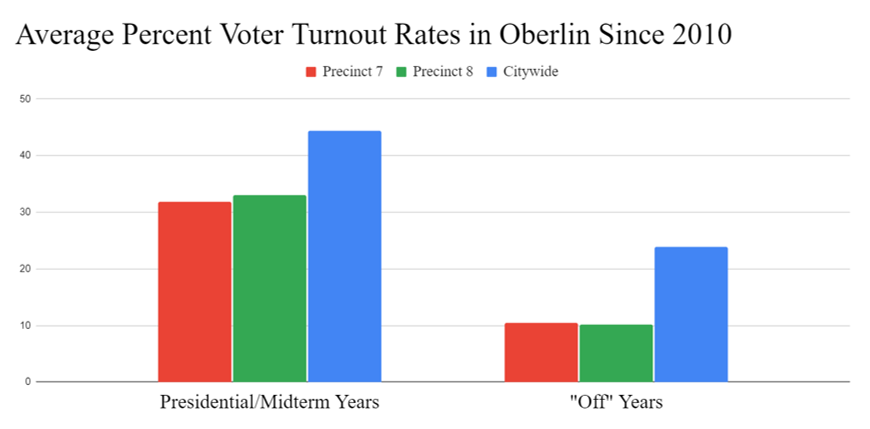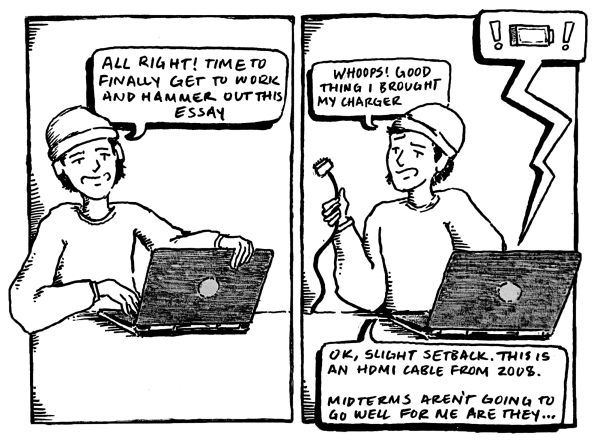Oberlin Students Fail to Show Up for Local Elections
“Where Was Voter Turnout Lowest? Oberlin College,” reads a Chronicle-Telegram headline from Friday, Nov. 5. For the first time since 2011, Oberlin precincts 7 and 8, which encompass the vast majority of the College’s student housing, saw voter turnout rates in the single digits — 2.92 percent and 1.56 percent to be exact. That amounts to 45 ballots from precinct 7 and 26 from precinct 8. Those numbers are astoundingly low by any measure, but for an institution with a student body that fancies itself to be politically-minded, fighting against the injustices of our world, they are particularly shameful.
It is understandable that this year would have lower turnout rates than normal. The last day to register to vote was Oct. 4, which was the first day of classes, and voter registration tables were set up on Sept. 29, when only first-years were moving in. Given one must update their registration each time they change addresses, and virtually every college student changes addresses each academic year, this likely made it impossible for many students to vote. The College also always has lower-than-City-average turnout, due in part to alumni who remain registered after graduating and moving away. COVID-19 has made it difficult for some of those who are registered to make it to the polls, as evidenced by the lowest rates since at least 2010 in every Oberlin precinct. Still, our community’s failure to show up cannot just be chalked up to circumstances beyond our control. This year, while an outlier, is just the most extreme data point in a consistent and concerning pattern.
Oberlin students consistently fail to vote in local elections. While every precinct in our town tends to have higher turnout for presidential and midterm elections, the effect is the most drastic in our precincts. Since 2010, in every presidential or midterm election year except 2014, the ratio of votes to registered voters, or turnout rate, in both precincts 7 and 8 has been more than half the turnout of the entire city. In every other year except 2011, it has been less than half.
I, admittedly, did not vote in Oberlin this year. Instead, I chose to submit an absentee ballot to my hometown of Amenia, NY to help protect our town council against a slate of candidates backed by a wealthy housing development looking to circumvent taxation and zoning laws. Still, I made a conscious choice to put my vote where I felt it was needed the most, and I did my civic duty. If you choose to vote at home instead of here, that is a perfectly fine choice. If you choose not to vote at all, I implore you to reconsider the impact that your voice can have. While one ballot may seem inconsequential, local elections are arguably where your vote matters most. For example, in my hometown election this year, one of the town council members achieved re-election by a margin of just three votes.
In light of the widespread apathy toward local elections, initiatives have cropped up to encourage more college students to vote. Princeton University’s Vote100 campaign, launched in 2015, aims to get 100 percent of eligible undergraduates to vote either in Princeton or at home and maintains a goal not to have any “off-years.”
“A lot of people think that national, and especially presidential, elections are the only ones that matter, and we’re trying to remind people that state and local elections have an equal, or greater, impact on their day-to-day lives,” Princeton fourth-year Joe Shipley said in a Nov. 2 news story from Princeton’s Office of Communications.
Across Division I colleges, the All Vote, No Play initiative is yet another program aimed at increasing voter turnout among students. Last year, the Division I council passed a piece of legislation to prohibit teams from engaging in “countable athletic related activities” such as games, practices, or required conditioning sessions on Election Day each year. Introduced by Georgia Tech Assistant Basketball Coach Eric Reveno, the measure aims to turn “a day off from athletics” into “a day on for civic engagement.”
Unfortunately, some colleges managed to get waivers signed this year that allowed them to continue athletic activities, but many others across the country eagerly participated in the initiative. Student athletic teams spent the day discussing the importance of civic engagement, visiting museums and elementary schools or staying on campus for assembly speakers.
In light of these programs’ successes, it is disheartening to see just how apathetic Oberlin students seem to have become toward local engagement. Students used to come up with creative campaigns to get out the vote like the #VotingIsSexy initiative of early 2020. College students, at Oberlin and elsewhere, must continue to be active participants in our democracy. We spend our days affecting change at a national level, but we fail to do so in our own community. We need to do better. Next time there is a local election, I urge you to take the time to learn about the candidates, make an informed choice, and go to the polls.



